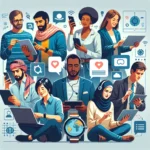Welcome to our IELTS Reading practice session focused on “Social media’s influence on corporate branding.” This topic has been increasingly prevalent in IELTS exams over the past few years, reflecting its growing importance in the business world. Given its relevance and frequency, there’s a high probability that you might encounter a similar theme in your upcoming IELTS test.
The Reading section of IELTS requires you to demonstrate your ability to understand complex texts, identify key information, and interpret the author’s opinions. Today, we’ll practice these skills with a passage about how social media impacts corporate branding strategies.
 Social media influence on corporate branding
Social media influence on corporate branding
Reading Passage
The Digital Revolution in Corporate Branding
Social media has revolutionized the way companies interact with their customers and build their brand image. In the past, corporate branding was largely a one-way communication process, with companies carefully crafting their messages and disseminating them through traditional media channels. However, the rise of social media platforms has transformed this landscape, creating a dynamic, two-way conversation between brands and consumers.
One of the most significant impacts of social media on corporate branding is the democratization of brand messaging. In the pre-social media era, companies had near-total control over their brand narrative. Now, consumers have the power to shape brand perceptions through their posts, comments, and reviews. This shift has forced companies to become more transparent and responsive, as any misstep can quickly escalate into a PR crisis in the digital realm.
Moreover, social media has enabled brands to personalize their marketing efforts to an unprecedented degree. Through data analytics and AI-driven insights, companies can now tailor their content to specific audience segments, increasing engagement and brand loyalty. This personalization extends beyond mere demographics, allowing brands to target consumers based on their interests, behaviors, and even real-time activities.
The immediacy of social media has also changed the pace of brand-building. Companies can now launch campaigns, respond to trends, and address customer concerns in real-time. This agility has become a crucial competitive advantage in today’s fast-paced market. However, it also presents challenges, as brands must maintain consistent quality and messaging across multiple platforms and interactions.
Another key aspect of social media’s influence on corporate branding is the rise of influencer marketing. Influencers, with their dedicated followings and perceived authenticity, have become powerful brand ambassadors. By partnering with influencers, companies can extend their reach and credibility, particularly among younger demographics. However, this strategy also carries risks, as an influencer’s actions can directly impact the brand’s reputation.
Social media has also blurred the lines between corporate and personal branding. Many company executives and employees now serve as brand representatives on social platforms, sharing insights and engaging with customers. This humanization of brands can foster stronger emotional connections with consumers but also requires careful management to maintain professional boundaries.
Finally, the global reach of social media has allowed brands to transcend geographical limitations more easily than ever before. Companies can now build international brand recognition and engage with global audiences without the need for extensive physical presence in foreign markets. This has leveled the playing field for smaller brands and startups, enabling them to compete with established multinational corporations on a global stage.
In conclusion, social media has fundamentally altered the corporate branding landscape. It has empowered consumers, personalized marketing, accelerated brand-building processes, leveraged influencer partnerships, humanized brands, and globalized brand reach. As social media continues to evolve, companies must adapt their branding strategies to remain relevant and competitive in this dynamic digital ecosystem.
Questions
True/False/Not Given
- Social media has transformed corporate branding from a one-way to a two-way communication process.
- Companies have more control over their brand narrative now than in the pre-social media era.
- Social media allows companies to personalize their marketing efforts based on consumer behavior.
- The pace of brand-building has slowed down due to the complexity of social media platforms.
- Influencer marketing is a risk-free strategy for enhancing brand credibility.
- Social media has made it easier for small brands to compete globally with larger corporations.
- All company employees are required to represent their brand on social media platforms.
Multiple Choice
-
According to the passage, which of the following is NOT a benefit of social media for corporate branding?
A) Increased transparency
B) Real-time customer engagement
C) Reduced marketing costs
D) Global brand reach -
The term “democratization of brand messaging” in the passage refers to:
A) Government regulation of social media
B) Equal access to social media for all companies
C) Consumers’ ability to influence brand perceptions
D) Democratic selection of brand ambassadors -
Which of the following is described as a challenge for brands in the social media era?
A) Maintaining consistent quality across multiple platforms
B) Reducing the number of marketing channels
C) Slowing down the pace of brand-building
D) Eliminating the need for traditional marketing
Matching Headings
Match the following headings to the correct paragraphs in the passage. There are more headings than paragraphs, so you will not use all of them.
A) The risks of influencer partnerships
B) Social media’s impact on brand control
C) The globalization of brand reach
D) The acceleration of brand-building processes
E) The merging of corporate and personal branding
F) The decline of traditional marketing methods
G) The rise of data-driven personalization
- Paragraph 3: __
- Paragraph 4: __
- Paragraph 6: __
- Paragraph 7: __
Answer Key
-
True – The passage states that social media has “transformed this landscape, creating a dynamic, two-way conversation between brands and consumers.”
-
False – The passage mentions that “In the pre-social media era, companies had near-total control over their brand narrative. Now, consumers have the power to shape brand perceptions.”
-
True – The passage states that “Through data analytics and AI-driven insights, companies can now tailor their content to specific audience segments, increasing engagement and brand loyalty.”
-
False – The passage indicates that “The immediacy of social media has also changed the pace of brand-building. Companies can now launch campaigns, respond to trends, and address customer concerns in real-time.”
-
Not Given – While the passage discusses both benefits and risks of influencer marketing, it doesn’t state that it’s risk-free.
-
True – The passage concludes by saying that social media “has leveled the playing field for smaller brands and startups, enabling them to compete with established multinational corporations on a global stage.”
-
Not Given – The passage mentions that many executives and employees serve as brand representatives on social media, but it doesn’t state that all employees are required to do so.
-
C – The passage does not mention reduced marketing costs as a benefit of social media for corporate branding.
-
C – The passage explains this term as referring to consumers’ ability to shape brand perceptions through their posts, comments, and reviews.
-
A – The passage states that the agility of social media “presents challenges, as brands must maintain consistent quality and messaging across multiple platforms and interactions.”
-
G – This paragraph discusses how companies can use data analytics and AI to personalize their marketing efforts.
-
D – This paragraph talks about how social media has changed the pace of brand-building, allowing for real-time responses and agility.
-
E – This paragraph discusses how social media has blurred the lines between corporate and personal branding.
-
C – This paragraph focuses on how social media has allowed brands to reach global audiences more easily.
Common Mistakes to Avoid
-
Misinterpreting “Not Given” statements: Remember, if the information is not explicitly stated in the passage, even if it seems logical, the answer is “Not Given.”
-
Overlooking key qualifiers: Pay attention to words like “some,” “many,” “all,” as they can change the meaning of a statement significantly.
-
Falling for distractors in multiple-choice questions: Always refer back to the passage and choose the option that best matches the information given.
-
Mismatching headings: Ensure you understand the main idea of each paragraph before matching it with a heading.
Vocabulary
-
Democratization (noun) /dɪˌmɒkrətaɪˈzeɪʃən/: The action of making something accessible to everyone.
-
Misstep (noun) /ˈmɪstep/: A mistake or error in behavior or action.
-
Unprecedented (adjective) /ʌnˈpresɪdentɪd/: Never known or done before.
-
Agility (noun) /əˈdʒɪləti/: The ability to move quickly and easily.
-
Transcend (verb) /trænˈsend/: To go beyond the usual limits of something.
Grammar Focus
Pay attention to the use of present perfect tense in the passage, for example:
“Social media has revolutionized the way companies interact with their customers.”
This tense is used to describe actions that began in the past and continue to have an impact in the present. It’s commonly used when discussing recent changes or developments, which is particularly relevant to topics involving technology and social media.
Tips for IELTS Reading Success
-
Practice active reading: Don’t just skim the text. Engage with it by asking yourself questions and predicting what might come next.
-
Improve your time management: Allocate your time wisely between reading the passage and answering questions.
-
Expand your vocabulary: Regular reading on diverse topics will help you encounter and learn new words in context.
-
Develop your skimming and scanning skills: These are crucial for quickly locating specific information in the text.
-
Stay calm and focused: Remember, the Reading section is designed to be challenging. Stay confident and trust in your preparation.
By practicing with passages like this one on “Social media’s influence on corporate branding,” you’re not only preparing for potential IELTS topics but also gaining valuable insights into contemporary business trends. Keep practicing, and you’ll be well-prepared for success in your IELTS Reading test!
For more IELTS Reading practice and tips, check out our guide on how social media influences brand loyalty.


